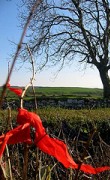 Late at night, somewhere in Ireland, a shadowy figure will be crossing the land. He or she will be holding in their hand, a bag, or box of eggs. They might bend to dig and bury an egg in a field, or creep closer to an outhouse and lay one gently inside straw or hay. The moon is almost full, so the light is good, and the ground is dry. It is a good night to be out in the fields with malice in your heart…
Late at night, somewhere in Ireland, a shadowy figure will be crossing the land. He or she will be holding in their hand, a bag, or box of eggs. They might bend to dig and bury an egg in a field, or creep closer to an outhouse and lay one gently inside straw or hay. The moon is almost full, so the light is good, and the ground is dry. It is a good night to be out in the fields with malice in your heart…
May Eve
This night is May Eve, the night before the 1st of May, the feast of Bealtaine, also known as Mayday. This is an old Celtic feast day that marked the start of summer, the day when cattle were driven out to pasture.
Bealtaine is calculated as a quarter day, between the Vernal equinox on March 21st and Midsummer Solstice on June 21st. This actually makes the real Bealtaine fall between the 5th and 7th of May.
This festival that welcomes the summer has some darker moments before the sun rises. This is the night for making pisheogs, a kind of Irish curse. They are made to bring ill health or ill- wealth to your neighbours.
Curses
My mother told me about a neighbourhood man who made pisheogs when she was a child in Craughwell, a small village in east County Galway. Her family kept a small farm in the locality.
On May Eve she and her sisters would be sent out; bottle of holy water in hand, to ‘bless the fields’ and keep them safe against pisheogs. She told me how everyone in the village knew the man who cast them, yet no-one would move to stop him. She would watch see him going down the road with his horse in the dark of night on his way to wander through their fields, to bury eggs in the land.
An egg was buried in the land with the intention to make the ground ‘go sour’, while one left in a barn or outhouse was to make the milk of a cow dry up, or to stop butter from being produced in the churn.
Churning
Another custom around butter, was that anything stolen from around a farm on May Day would ‘steal the butter’ from the house. This meant that the victim’s churn wouldn’t produce any butter and the thief would benefit from added wealth.
Churning itself was mostly avoided on Bealtaine, unless a drop of holy water was added. No fire was allowed to be leave the house, so any man smoking had to smoke his pipe within the walls. If he left with the pipe lit, it was feared that the luck of the house would leave with it, and this would affect the butter.
If all precautions had been made, and the butter still wasn’t appearing during churning, then it was suspected that evildoing and pisheogs were to blame. The cure for this was to plunge a red-hot tongs deep into the churn to burn away the evil.
May Bush
In my local villages of Ennistymon and Lahinch, in County Clare on the West Coast of Ireland, you can see branches left or tied outside doors to protect against the pisheog. They must be left by another neighbour however, not yourself. I’ve noticed that the branches I’ve seen left are horse chestnut, I’m not sure if that is particular to this custom.
The May Bush is another custom on May 1st. A tree, usually a rowan or hawthorn is decorated with cloths, ribbons and egg shells. This bush welcomes in the summer as well as warning off bad luck.
Bonfires
Bonfires were lit on May Eve in ancient times on the hill of Uisneach, in the midlands of Ireland, known as the ‘navel of Ireland’. This was an important spiritual and political centre of Ireland, situated in County Westmeath. This custom has died out in most areas, but still continues in some parts of Galway and Limerick.
May the 1st has also some connections with the Virgin Mary in Ireland. At the foot of the Paps in County Kerry in Southwest Ireland, there is a holy well sacred to the Virgin Mary. The well sits in an old fort called Cathair Crobh Dearg.
Clockwise
On the Sunday closest to Mayday rosaries are said in a clockwise direction around the fort. Incidentally the Paps Mountains are said to be the breasts of the Goddess Danu an ancient Munster Goddess.
Mayday is the festival celebrated during the Seventies cult horror film ‘The Wicker Man’. In this film a police officer is unwittingly lured to an island in Scotland where ‘pagan’ practises still are practised. Many old Mayday customs are shown in this film, including Maypole dancing. However the islands inhabitants have darker things in mind for their guest…
While many of the customs of pisheogs and May bushes have died out, you can still find evidence of them continuing, in particular around County Clare. Especially around my house…
+Share+

Long may day continue…
great piece. more please.